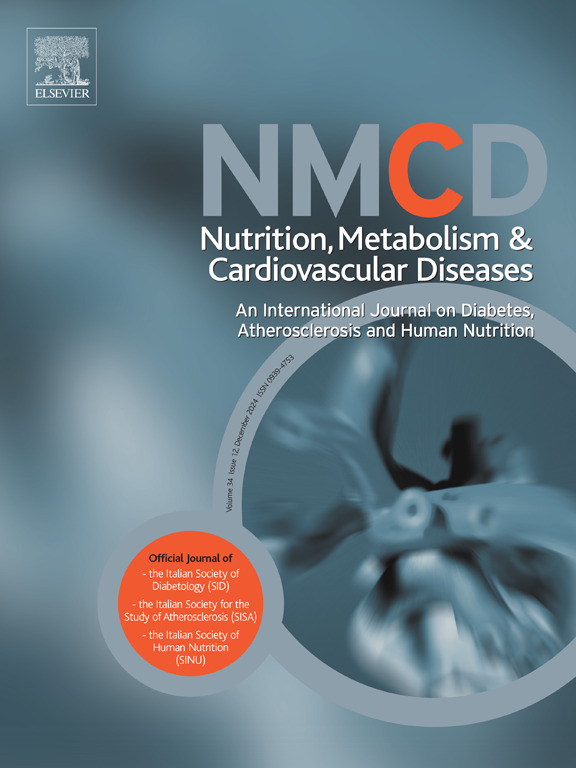急性心力衰竭住院患者血清尿酸波动与心血管预后
IF 3.7
3区 医学
Q2 CARDIAC & CARDIOVASCULAR SYSTEMS
Nutrition Metabolism and Cardiovascular Diseases
Pub Date : 2025-03-24
DOI:10.1016/j.numecd.2025.104025
引用次数: 0
摘要
背景和目的:本研究探讨急性心力衰竭(HF)患者住院期间血清尿酸(SUA)波动模式与临床结果之间的关系,这种关系尚未完全了解。方法和结果:1403例急性心衰患者入组,中位随访20.5个月。评估的结局包括心血管(CV)死亡和/或心力衰竭住院(CV死亡和HHP)、CV单独死亡和全因死亡率(ACM)。限制三次样条分析了入院SUA水平与预后之间的关系。根据患者入院和出院时的SUA水平将患者分为4组:1)两点SUA正常(N&N), 2)入院时SUA升高,出院时正常化(H&N), 3)入院时SUA正常,出院时升高(N&H), 4)两点SUA升高(H&H)。采用COX多元回归分析评估SUA类别与结果之间的关系。结果显示,入院时SUA升高预示预后不良。然而,与N&N组相比,N&H组和H&N组的CV死亡率和HHP、CV死亡率或ACM均没有显著增加。H&H组的CV死亡风险最高(校正HR 1.79, 95% CI 1.10-2.93), ACM(校正HR 1.64, 95% CI 1.08-2.49), CV死亡和HHP(校正HR 1.79, 95% CI 0.99-2.93)的风险增加趋势不显著。结论:住院期间持续升高的SUA水平与急性HF患者的不良心血管结局和ACM独立相关,而SUA水平的波动没有表现出类似的关联。本文章由计算机程序翻译,如有差异,请以英文原文为准。
Serum uric acid fluctuations and cardiovascular outcomes in hospitalized acute heart failure patients
Background and aims
This study examined the association between serum uric acid (SUA) fluctuation patterns during hospitalization in acute heart failure (HF) patients and clinical outcomes, a relationship not fully understood.
Methods and results
A cohort of 1403 acute HF patients was enrolled with a median follow-up of 20.5 months. Outcomes assessed included cardiovascular (CV) death and/or heart failure hospitalization (CV death & HHP), CV death alone, and all-cause mortality (ACM). Restricted cubic splines analyzed the relationship between admission SUA levels and outcomes. Patients were categorized based on admission and discharge SUA levels into four groups: 1) Normal SUA at both points (N&N), 2) Elevated SUA at admission, normalized at discharge (H&N), 3) Normal SUA at admission, elevated at discharge (N&H), and 4) Elevated SUA at both points (H&H). Associations between SUA categories and outcomes were assessed using COX multivariate regression analysis. Results showed elevated SUA at admission predicted poor outcomes. However, neither N&H nor H&N groups displayed significant increases in CV death & HHP, CV death, or ACM compared to N&N. The H&H group had the highest risks for CV death (adjusted HR 1.79, 95 % CI 1.10–2.93) and ACM (adjusted HR 1.64, 95 % CI 1.08–2.49), with a non-significant trend towards increased risk of CV death & HHP (adjusted HR 1.79, 95 % CI 0.99–2.93).
Conclusion
Persistently elevated SUA levels during hospitalization were independently associated with adverse cardiovascular outcomes and ACM in patients with acute HF, whereas fluctuations in SUA levels did not exhibit a similar association.
求助全文
通过发布文献求助,成功后即可免费获取论文全文。
去求助
来源期刊
CiteScore
6.80
自引率
2.60%
发文量
332
审稿时长
57 days
期刊介绍:
Nutrition, Metabolism & Cardiovascular Diseases is a forum designed to focus on the powerful interplay between nutritional and metabolic alterations, and cardiovascular disorders. It aims to be a highly qualified tool to help refine strategies against the nutrition-related epidemics of metabolic and cardiovascular diseases. By presenting original clinical and experimental findings, it introduces readers and authors into a rapidly developing area of clinical and preventive medicine, including also vascular biology. Of particular concern are the origins, the mechanisms and the means to prevent and control diabetes, atherosclerosis, hypertension, and other nutrition-related diseases.

 求助内容:
求助内容: 应助结果提醒方式:
应助结果提醒方式:


